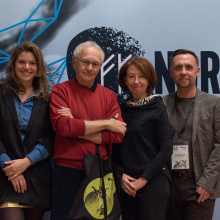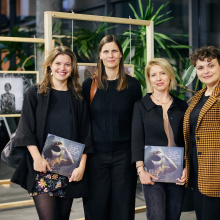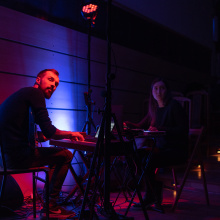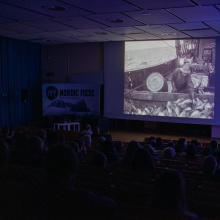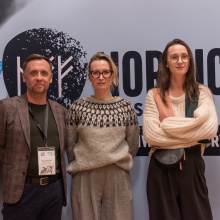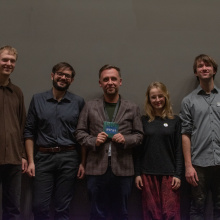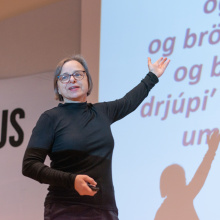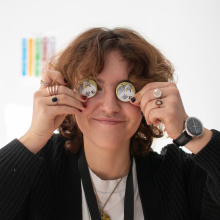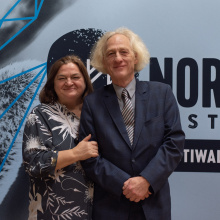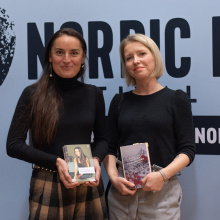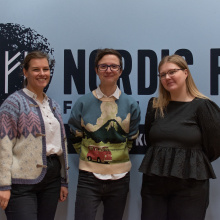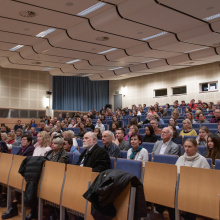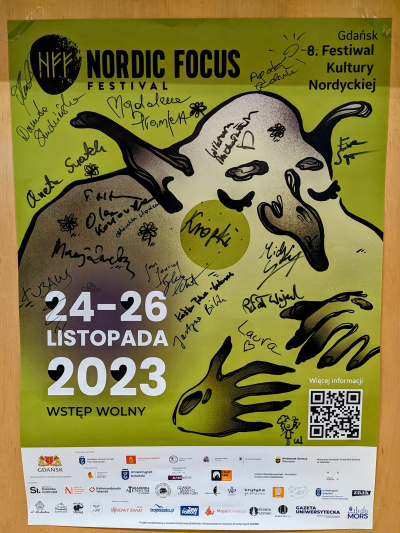
The eighth edition of the international cultural project Nordic Focus Festival has come to an end. As every year, the event organisers took the participants on an unforgettable journey through the frosty, constantly astonishing Nordic countries.
The first day of the festival (November 24)
The festival began with an official welcome to the guests by the Vice-Chancellor for Students and Educational Quality, dr. hab. Arnold Kłonczyński, prof. UG, who was accompanied by this year's mascot, the festival Troll. Then, it was the turn of the individual events.
The first day of the festival was dominated thematically by Ultima Thule, i.e. Iceland. Visitors flocked to the first panel to hear about Icelandic film, painting, and photography. The audience was taken into the world of northern visual art by Emiliana Konopka (author of the website Utulę Thule and specialist in culture, science and communication at the Icelandic Embassy in Poland), Anita Horowska (architect and photographer) and dr Wiktoria Michałkiewicz (art curator). The discussion was moderated by an expert on Nordic cinema, author of the book ‘Icelandic Cinema. Tradition and Postmodernity’, dr Jakub Konefał. The audience's emotions had not had time to subside when, immediately after the discussion, a unique screening of one of Iceland's oldest documentaries, ‘Iceland in Moving Images’, began. Atmospheric music, performed live by the band Kropki, added magic to the final event of the evening.
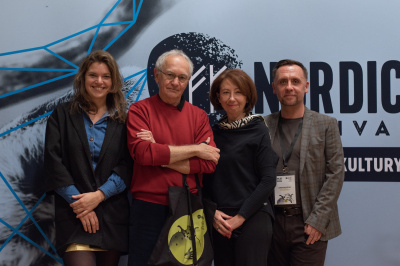
Second day of the festival (November 25)
The second day of the festival began with a series of language workshops. Swedish was presented first, followed by the struggles of Finnish and Norwegian language enthusiasts. We then moved on to the lecture part of the festival. The segment began with a talk by Katarzyna Paluch-Łukasiak on the sounds of Iceland. The artist presented to the audience the effects of her work on the 'Noise from Island - Hidden People' project, carried out with her wife, photographer Magdalena Łukasiak. Participants in this meeting had the opportunity to listen to, among other things, the noise of cold caves or the crackling of solidifying lava. The author of the sound map of Iceland showed how she samples the island's voice to create unique music. An extension of the project was an inclusive exhibition that crossed the boundaries of visual and auditory experience, enabling everyone, including blind people, to immerse themselves in the sensory-filled world of Iceland's nature, folklore and cultural heritage.
From nature, we quickly moved on to political themes, namely the presentation ‘Yellow and Blue. On Swedishness in a multicultural society’, which was prepared by Jan Janczy. The journalist from Radio Nowy Świat gave an interesting behind-the-scenes account of the formation of Swedes' current identity, so it was no surprise that a full house listened to him. Without a doubt, Janczy successfully introduced the audience to the phenomenon of the diversity of Swedish society.
Next came the panel 'A country (not) for everyone? On the Swedish theory of the happy state'. Distinguished interlocutors: Maciej Zaremba Bielawski (journalist of 'Dagens Nyheter' and author of several reportage books on Swedish social and immigration policy), dr Wiktoria Michałkiewicz (graduate of the Polish School of Reportage, cultural studies, and Swedish philology) and Magdalena Pramfelt (President of the Polish-Swedish Chamber of Commerce and Honorary Consul General of Sweden) presented a picture of the northern country and its history on many levels, often standing in opposition to the openness to everyone attributed to Sweden.
Saturday evening began with a meeting with Rafał Wojczal (author of the photo essay ‘Ekonomiczni pielgrzymi - obiektywnie o Polakach w Norwegii’ [‘Economic pilgrims - objectively about Poles in Norway’]), hosted by Krystyna Weiher-Sitkiewicz, who has supported the festival with her presence for many years. During the dynamic discussion at the meeting, Rafał Wojczal dispelled some of the stereotypes about Poles in Norway and - with a wry smile - reinforced some of the others.
The room was also full at the meeting with dr Ewa Sapieżyńska, who talked about her book ‘I am not your Pole’. The writer allowed the audience to go deep into the story - both her own and that of other Polish-Norwegian immigrants. The complex structure of the stories quoted by the speaker proved amazing.
The festival's penultimate day culminated with a screening of the award-winning film ‘Norwegian Dream’, accompanied by a conversation with the director, Leiv Igor Devold, and the screenwriter, Justyna Bilik. The screening prompted a wave of questions. It turned out that the story of the Polish immigrant Robert (Hubert Miłkowski) moved the audience immensely.
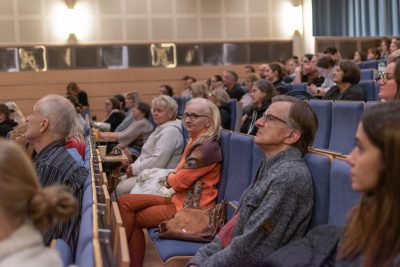
Third day of the festival (November 26)
The last, but no less attractive, festival day began with another language workshop, this time on the basics of Norwegian, Icelandic and Danish. During the workshop, it was possible to find out where to start learning any Nordic language and learn a few linguistic titbits.
In her lecture entitled 'Döstädning - the art of putting one's life in order in Swedish', dr Agata Rudnik from the Psychological Support Centre at the UG showed how to slow down a bit in the rush of life and organise everyday matters in the 'Scandinavian way', i.e. in a way that differs significantly from our approach in Poland.
On Sunday afternoon, festival-goers were taken to the more distant Nordic countries, namely Iceland and the Faroe Islands. The multicoloured stories about Iceland were presented by Aleksandra Kozłowska and Mirella Wąsiewicz, authors of the book ‘Iceland and the Poles. Stories of those who were not afraid to take a risk’. They showed us the glories and shadows of life on the icy island and, above all, quoted the opinions of those who decided to change their lives by one hundred and eighty degrees by moving to Iceland.
In turn, we were taken to the Faroe Islands by festival regular Kuba Witek, who this time came not with a film but a book entitled 'Escape from the Faroe Islands'. Among other things, Kuba Witek told the audience about the gradual changes in the lives of the archipelago's inhabitants, from the challenging beginnings of the first settlers to a life of prosperity and the resulting consumerism.
We were taken on yet another journey through Denmark by Jan Janczy and dr. hab. Sylwia Izabela Schab, prof. UAM. The author of the book 'Denmark. Peace lives here', presented her impressions of Danish society's general friendliness and general characteristics. The philologist focused on the warm nature of the Danes, highlighting the little aspects that make their country extremely friendly to live in.
After Denmark, it was once again time for Iceland. Here, an interview with Agnieszka Szydłowska, a journalist passionate about all forms of artistic expression, yielded plenty of interesting details about life on the icy island. Apart from the topic of Iceland's unique musical culture, the journalist also touched on other interesting issues, such as the phenomenon of Icelandic jumpers or the islanders' approach to their relationship with their bodies. As a result, the meeting combined spiritual and physical elements, giving participants a very personal insight into the characteristics of the frosty land.
After the final keynote lecture, the festival moved to the Neo-Philology building, where the photography exhibition 'Places Beyond | Places Within Us' awaited festival-goers. Its Norwegian author, Erle M. Kyllingmark, supplemented the unusual photographs with her comments. The analogue plates, on which she applied a multi-exposure effect, evoked a purifying experience among the audience.
The final element of this year's festival adventure was a jazz concert by the band PESH. The group played songs from their latest album, PESHISH. The event gathered a full house of listeners, who were offered a journey through the intriguing original compositions of the formation's members. It would be hard to find a better finale for an event as rich as this year's Nordic Focus Festival undoubtedly was.
***
To conclude, it is worth mentioning that the Nordic Focus Festival this year also took place within the walls of the building of the Ethnography Department of the National Museum, where art and environmental workshops for young people entitled ‘Recycled Trolls and Elves’ led by Kamila Szelągowicz-Przewoźniak occurred. During the workshop, participants made durable canvas bags with motifs typical of Scandinavian folklore and broadened their knowledge of ecology.
This year's festival was realised within the framework of the statutory activities of the Jantar Artistic Initiatives Association in cooperation with the University of Gdańsk and subsidised by the City of Gdańsk.
Festival curator: Tomasz Pupacz
Event coordination and public relations: Alicja Szczudlińska
Social media: Aleksandra Mętel
Hosting author meetings and discussions: Magdalena Pramfelt, Jakub Sebastian Konefał, Krystyna Weiher-Sitkiewicz, Anna Ratajczak-Krajka
Festival team: Zuzanna Litwinko, Agnieszka Grzegowska, Paweł Herman, Anna Czapska, Barbara Madany, Michał Biełuszko
Volunteers: Kaja Yushchenko, Ksawier Szczechowski, Miron Hałagida, Antek Majewski, Michał Kozioł, Magda Budzko, Kamil Sulak-Kozłowski, Antek Majewski, Maciej Rozenkiewicz, Kasia Kogut, Miron Hałagida, Norbert Madej, Melania Broda
Video recording and editing of footage: Janusz Wojtkowski
Photo reportage: Zuzanna Litwinko
Technical support: Wiesław Cyganik
Festival graphic design: Michalina Ochrymiuk
Animation: Krzesimir Jagiełło

